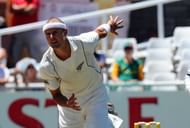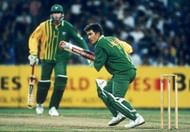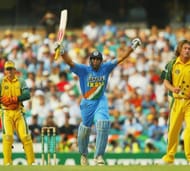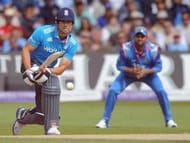England's controversial ICC World Cup win raised the bar of expectations for every future final of an ICC tournament. In the last 5 overs of England's innings, the pendulum swung back and forth after every ball. Even the 'Super Over' couldn't separate the two sides and the English were handed their first-ever World Cup victory due to a rather bizarre ' boundaries' rule.
One has to feel for New Zealand. They gave their everything and didn't come up short as they matched England for every stat but for the one that was to decide the game.
Growing up, it is the dream of any budding cricketer to represent his / her country and to play in and if one is lucky enough, to win the World Cup. However, not every fine cricketer is lucky enough to get an opportunity to play in a World Cup. Let's take a look at five such unlucky players.
#5 Matthew Hoggard
Matthew Hoggard's credentials as a Test Bowler for England are imperious. He is the ninth highest wicket-taker for the country which invented the game with 248 scalps including a hat-trick against the West Indies at the Kensington Oval at Barbados. He claimed a career-best haul in Test Cricket of 12 for 205 against South Africa at The Wanderers in Johannesburg. He played a stellar role in England's triumph in Ashes 2005, dubbed the series of the century by many. He was on the receiving end of the 'Universe Boss' Chris Gayle's fury, becoming the first bowler to be hit for six fours in an over
Analysis of ODI Career: The Yorkshire man did not have a successful ODI career. He made his debut in the shorter format of the game in 2001 under the tutelage of England captain Nasser Hussain and coach Duncan Fletcher. He could muster only 26 matches picking up 32 wickets at an average of 36 in the process. Being a swing bowler, he usually was the target of opposition batsmen when the ball stopped swinging or in conditions not conducive to swing bowling. He would also be taken apart at the death due to lack of variety and over-dependence on line and length bowling. His ODI career came to an abrupt end in 2006 against India.
Why he missed out on a World Cup match: Hoggard was included in the England squad for the 2003 ICC Cricket World Cup but never got a game, with England preferring Steve Harmison and Andrew Caddick to go along with the all-round abilities of Andrew Flintoff and Ronnie Irani. By the time the 2007 edition came calling, he had already played his last ODI for England.
#4 Chris Martin

Chris Martin played Test Cricket for New Zealand from 2000 to 2013. In those thirteen years, he was a constant as New Zealand tried a variety of pacers to find the right combination. Some changes were voluntary, some were forced down their throat due to unfortunate injuries.
It seemed Chris Martin was born to play second fiddle to the sensational Shane Bond. Martin could shore-up one end with clinical accuracy whilst Bond went on a rampage from the other. This would be the Kiwis' combination only in about 15 Tests that the pair played together.
By the end of his Test career aged 38, he was the island country's third-highest wicket-taker with 233 scalps but has now been surpassed by Trent Boult (246) and Tim Southee (244).
Analysis of ODI Career: Despite having a stellar Test career, he never featured in the Black Caps' plan for the shorter forms of the game and garnered only 20 sporadic appearances in ODIs spread over 7 years. Having made his debut in January 2001 against Zimbabwe, he garnered 18 wickets and played his last ODI against England in February 2008. Another aspect of Martin's career his comical inability with the bat. This would ultimately cost him a regular place in the ODI and T20I sides. He holds the dubious honour of having taken more wickets than runs scored (123), a record he shares with India's BS Chandrashekhar.
Why he missed out on a World Cup match: When Martin made his debut, New Zealand had fine all-rounders in abundance with the likes of Chris Harris, Chris Cairns and Craig McMillan featuring regularly. Later, Scott Styris and Jacob Oram took over the mantle. For someone with almost no ability with the bat, it was always going to be difficult for Chris Martin to force his way into the ODI side. Being a line and length bowler, he would ostensibly become predictable in the death overs and this may well have resulted in him not playing a World Cup game.The closest he came to playing for New Zealand in a World Cup was when he was named a replacement player for Darryl Tuffey in the 2007 edition. Unfortunately, he couldn't get a game.
#3 Justin Langer

Four most astonishing stats of Justin Langer's career:
1. He played more innings in Test Matches (182) than he scored runs (160) in ODIs.
2. He played more innings in Test Matches (182) than he faced balls (180) in ODIs.
3. He played his last ODI (May 1997) almost a decade before he retired from Tests (January 2007).
4. He never played an ODI in Australia.
To the untrained eye, Justin Langer was a subdued batsman, a grafter who benefitted from his bludgeoning partner Matthew Hayden's assertiveness and got runs the 'hard way'. He was seen as someone who is always a couple of failures away from being dropped and forgotten. Well, that could not be farther from the truth.
'Alfie', as he was known to his teammates, always played the game his way. In and out of the side in throughout the '90s, like most Australian Test openers, he played only 8 Tests for the first six years into his career. Having made his debut against the Windies in January 1993 at Adelaide, he was hit on the helmet by Ian Bishop, scoring 54 runs.
Analysis of ODI Career: He made his ODI debut in 1994 against Sri Lanka at Sharjah. He didn't get the opportunity to bat as Mark Taylor and Mark Waugh chased down the modest target of 158 in 37 overs. He was given just six more opportunities over a year and was ultimately dropped from the side.
Why he missed out on a World Cup match: With only 7 caps to his name, he was deemed too inexperienced to be selected for 1996 World Cup. After the showpiece event, he was given only one more opportunity to represent Australia in coloured clothing, against England at Lord's in 1997 scoring 36. Despite having a strike rate of 89, the presence of Mark Taylor, Mark Waugh, Adam Gilchrist and Matthew Hayden at the top of the Australian batting order was the main reason Justin Langer missed out on the ODI format and thereby, a World Cup appearance.
#2 VVS Laxman

In 2003-04 Australian tour, Sachin Tendulkar was going through a rather tedious batting patch. He was just not getting starts and when he did get a start, he was sure to be undone by his nemesis, well, not the Australian bowling attack but West Indian umpire Steve Bucknor. When the team reached Sydney, Tendulkar told his teammates that he just wasn't going to play the cover drive, one of his favourite shots and also the one to which he was getting out.
Tendulkar walked in to bat at the fall of Aakash Chopra's wicket at 128 for 2 and when Rahul Dravid fell to Jason Gillespie at 194, he was joined in the middle by the 'Very Very Special' Laxman. Tendulkar later said that it was a privilege to have the best spot in the stadium watching Laxman's innings of 167. Maybe Laxman was repaying the favour he had when he was the non-striker as Tendulkar was playing one of his most majestic innings at Sharjah against Australia, which later would become famous as the 'Desert Storm'.
Analysis of ODI Career: Laxman made his ODI debut in 1998 against Zimbabwe at Cuttack and was out for a duck. Interestingly, he was also out for a duck in his last ODI against South Africa at the Centurion. The 134 Test veteran could only muster a paltry 86 ODI appearances. What let him down in the shorter format was his reading of the game.
Whilst he could assess situations perfectly in Tests, he couldn't do the same in ODIs and as a result, he was given a sustained run in the team. Low strike rates in the early part of his career also didn't help him. In all, he scored 6 centuries, the last coming against Pakistan at Lahore and his highest ODI score is a 131 not out against Zimbabwe at Adelaide. He scored his four other centuries against Australia.
Why he missed out on a World Cup match: Just as in the case of Justin Langer, he was deemed to be too inexperienced to be selected for the 1999 World Cup having played only 7 matches, scoring just 62 runs in the process. Having been in good batting form in the lead up to the 2003 edition in South Africa, he was controversially overlooked with the team management opting for Dinesh Mongia instead. Captain Sourav Ganguly later admitted that it was a mistake to have not picked Laxman for the tournament. By the time the 2007 edition rolled along, unbeknownst at the time, Laxman had already played his last ODI for India. Unlike in 2003, he surely would have been relieved to have not been a part of the disastrous campaign in 2007!
#1 Sir Alastair Cook

Current World Champions England's highest Test runs scorer and highest Test century getter could never get a proper look-in the ODI side.
It is often said that left-handers look more elegant to the eyes than right-handers. Brian Lara, Sourav Ganguly, Kumar Sangakkara, Clive Lloyd and Mark Taylor before them are certainly examples that prove that age-old adage. Sir Cook's technique and shot-making, however, was not the most appealing to the Cricket purist. What it was was effective, well, at least in Test Matches.
Analysis of ODI Career: Four months after having made his successful debut against India at Nagpur in 2006, he debuted in ODIs at Lancashire's Old Trafford Stadium in Manchester and played just one more ODI before the 2007 World Cup with scores of 39 and 41.
Post the showpiece event in 2007, he was then given an extended run in the English ODI side throughout 2007 and 2008, scoring a century against India at Southampton but mostly failing to kick on from there. He was then dropped and then inducted in the team a year and a half later in 2010 against Bangladesh. He performed well, scoring 156 runs in 172 balls in three innings with two half-centuries.
Back in the side post the 2011 tournament, Sir Cook hit a century in only his second comeback match against Sri Lanka at Lord's. He made consecutive centuries on spin-friendly slow-and low pitches in Abu Dhabi against Pakistan in February 2012 and added another against the West Indies in June of the same year. He was then made captain and given another extended run in the ODI team throughout 2013 and 2014.
Why he missed out on a World Cup match: Just as in the case of Justin Langer (in 1996) and VVS Laxman (in 1999), he was thought to be too inexperienced to be selected for the 2007 World Cup having played only two ODIs. He was mysteriously dropped from the side despite having scored runs at a strike rate of almost 90 and an average of 52 (albeit the sample size was only 3 matches) against Bangladesh and missed out on the 2011 World Cup. Having been the captain in the build-up to the 2015 World Cup, he was controversially stripped of the captaincy and dropped from the side in late 2014, just a couple of months before the 2015 World Cup.
Follow IPL Auction 2025 Live Updates, News & Biddings at Sportskeeda. Get the fastest updates on Mega-Auction and cricket news
